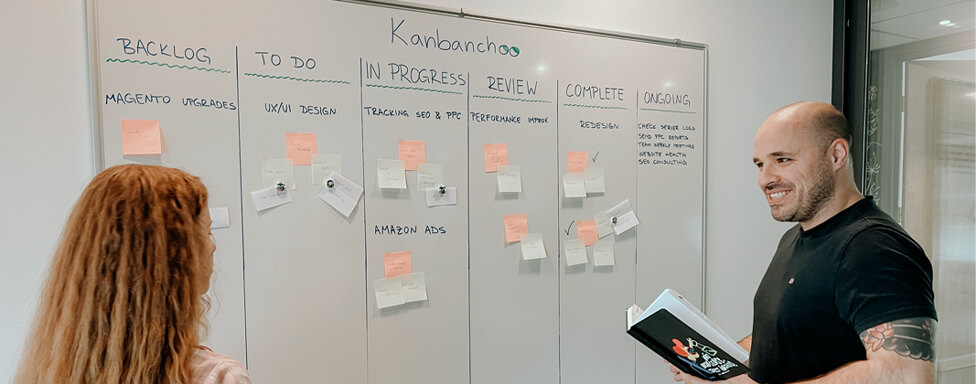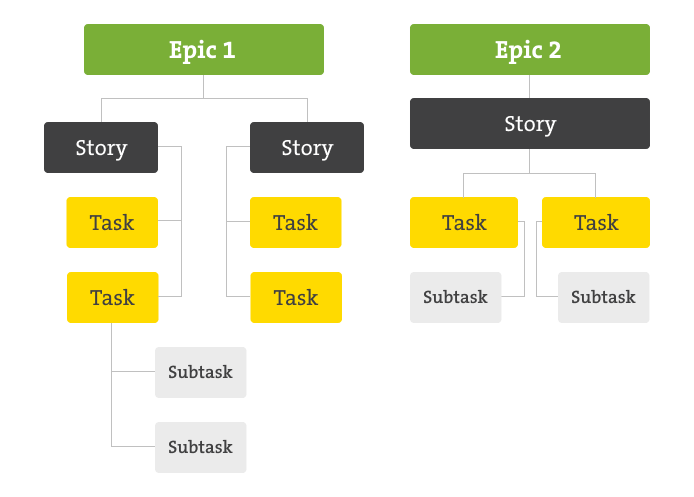Managing Workflows at Inchoo with Kanban Methodology

In our blog section, we’ve covered a wide range of topics related to our full-service eCommerce business. However, one area we haven’t explored in depth is project management. In this article, we’re excited to take you behind the scenes at Inchoo and shed light on our project management practices. Specifically, we’ll delve into why we’ve chosen the Kanban methodology as our preferred approach for managing workflows effectively.
As the business landscape becomes increasingly dynamic and competitive, organizations are constantly seeking ways to optimize their project workflows and ensure seamless execution. This is where project management and methodologies like Kanban come into play, providing a structured framework for teams to effectively manage tasks, prioritize work, and achieve project objectives with unparalleled efficiency.
So let’s dive in and see how we adopted this methodology for our projects!
The Importance of Project Management
Why do we need project management and what is its purpose? Project management is a crucial element in our operations. It serves as the driving force behind our success, ensuring that projects are executed seamlessly and deliver exceptional outcomes.
Our project management approach revolves around establishing clear goals and objectives for each project. By defining specific, measurable targets, we create a roadmap that guides our team throughout the project lifecycle. This focus on goal clarity enables us to effectively align the efforts of our teams, maximizing efficiency and productivity.
Project management goes beyond goal setting. We emphasize meticulous planning, resource allocation, and task management. By breaking down projects into manageable phases and assigning responsibilities to skilled team members, we optimize team utilization and minimize bottlenecks. This systematic approach enables us to meet project timelines and deliver high-quality solutions to our clients.
Communication and collaboration are integral components of our project management methodology.
We encourage transparent and open communication channels, ensuring that all stakeholders, including team members and clients, are well-informed throughout the project lifecycle.
This promotes a sense of trust, encourages active collaboration, and enables prompt decision-making to overcome challenges and keep projects on track.
In summary, project management is a necessary part of our operations. Our approach focuses on clear goal setting, meticulous planning, and effective communication. By adopting these project management principles, we consistently deliver successful projects, meeting client expectations and solidifying our position in the market.
Kanban methodology in project development
Now that we’ve introduced the world of project management at Inchoo, it’s time to delve deeper into why we have chosen the Kanban methodology as our preferred way of work. As we strive for efficiency and seamless execution in our projects, this approach has proven to be instrumental in achieving these goals.
Many of today’s companies are using agile methodologies and adopting their principles for leading multiple projects, from smaller ones to big ones. Agile methodologies have proven to be effective, especially in the IT industry, however, it is not always easy to choose which methodology we should use or embrace in the company system.
Depending on the project type, complexity, available team members and their expertise, the project budget, etc., we decide if we are going to use waterfall or agile, Kanban or Scrum.
At Inchoo we embraced the Kanban methodology, as for us it has proven to be the most effective and efficient due to its visual nature, flexibility, and the possibility to focus on continuous improvement.
Many companies that embraced Kanban as a way of working are using standard sections on their board. But some of them, like us, have managed to incorporate standard board sections with a few modifications to adopt this methodology in the best possible way.
With a few adaptations, we managed to adapt to the different project types and align with their needs. So, we may say that we improved our Kanban board to better serve our needs and to get better visibility on the projects.
To achieve that, we utilized activeCollab, a project management tool, to implement Kanban boards. Tasks are categorized into distinct sections, including:
- Backlog – serves for tasks that are planned to be done, but not yet ready for work. In backlog Project Manager puts a task that is in plan to be done, but we still do not have all the necessary information, or tasks that will be done but not just yet.
- TO DO – once we have all of the information to execute the task, and once the functionality is ready to be developed, a PM moves the task into this column and assigns it to the dedicated specialist.
- In Progress – this column represents the tasks that are currently in progress, or tasks which are currently in development.
- Review – when a task is done, specialists move it into the review column. This means that tasks are done and should be reviewed by the Project Manager and/or a client.
- Complete – column that represents those tasks that are completed and reviewed. Once the PM or a client confirms that everything is working as agreed tasks are moved into the complete column.
- Ongoing – sometimes there are tasks that are never completed, and those tasks are placed into the Ongoing column. Those are usually tasks that include Continuous SEO research, log cleanups, and project management work. In other words, tasks on which we are continuously working.
This visual representation allows our teams to track the progress of tasks, identify bottlenecks, and ensure a smooth flow of work throughout the project lifecycle.
So, not that we introduced you to our possible task statuses, let’s see how we organize our work.
To have a much clearer picture and understanding of the project functionalities we have to separate our work into several dependencies, as this allows us to easily track all the work that should be done or that was done.
Our work is divided into the following requirements:
- EPICS – larger bodies of work that are broken down into user stories.
- USER STORIES – descriptions of features that are written from a perspective of an end-user.
- TASKS – a piece of work that should be done.
- SUBTASKS – pieces of work that should be done as a part of a task or user story (usually if the task is of greater scope we divide him into the smaller sub-tasks)

Dividing work this way has many benefits. These segmentations allow us to have much better visibility of our work, but also it is easier to track timelines and project budgets, and it allows us to have easier and cleaner communication.
At Inchoo, we encourage communication via tasks or user stories. So you probably think why are we doing this, and isn’t it better to do it via email?
Well, that depends on the topic. Practicing communication through a collaboration tool (in our case activeCollab), itself is much more transparent. So, imagine that we are working on some functionality development, like ERP integration. We would have a special user story and tasks opened for that specific aspect (Epic). To avoid multiple email replies or constant online meetings where some of the information can be lost, we separate our conversations through each task separately. This way allows us to have all the information regarding specific topics in one place and divided from the other topics that are not relevant to each other. This gives us a better overview of the general communications, and our clients can easily track what is happening and what we agreed on.
Besides easier and more transparent communication, separating our work into the segments mentioned above, allows us to easier track time spent on those tasks which is important for minimizing the possibility to go over the planned budget or agreed timeline.
Kanban methodology gives us a bigger picture of the project, and due to its visual nature, it is easier to track progress and mitigate the possible risks that can occur.
Learning and Development
In conclusion, implementing Kanban methodology in e-commerce, particularly within Magento-based businesses, has proven to be a game-changer. We introduced Kanban into our work in 2019., and with time we managed to get better productivity and efficiency. Not only that it helped us to organize our work better, it improved clarity of the progress to Clients. In short, we became more flexible and transparent, and our clients appreciated the change.
Our utmost priority is to foster transparency and facilitate a clear understanding of project requirements for both our clients and our team.
Now that you are familiar with our work and why we chose the Kanban methodology for our way of work, let us know which methodology suits you best, and which one you prefer more, Scrum or Kanban, or maybe waterfall?


